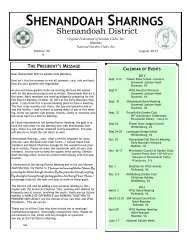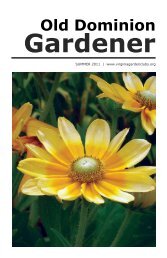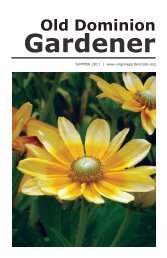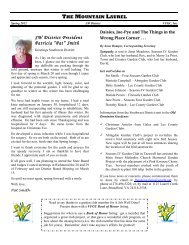Fall - Virginia Federation of Garden Clubs
Fall - Virginia Federation of Garden Clubs
Fall - Virginia Federation of Garden Clubs
- No tags were found...
You also want an ePaper? Increase the reach of your titles
YUMPU automatically turns print PDFs into web optimized ePapers that Google loves.
Edible GARDENING<br />
FRESH SALAD FROM THE COLD FRAME<br />
Submitted by Barbara Smith, VFGC Edible <strong>Garden</strong>ing Chairman<br />
The snow is falling and the taste <strong>of</strong> fresh vegetables are<br />
becoming a distant memory. Does this mean several more<br />
months <strong>of</strong> bagged salads No! You can soon enjoy fresh<br />
salads by growing great-tasting spinach, radishes, green<br />
onions, lettuce, and other vegetables in a cold frame. A<br />
cold frame works as a miniature greenhouse and with little<br />
care it can add a month to the front end <strong>of</strong> salad season.<br />
Building a cold frame - A cold frame is easy to construct<br />
and you probably have most or all the materials on<br />
hand. It can be as simple as placing a discarded window sash or shower door over a<br />
group <strong>of</strong> straw bales arranged to form a rectangular base. More typically, the cold frame<br />
is a floorless box constructed from sturdy 2’ by 8’s or 2’ by 10’s and sized to fit under<br />
glass or similar transparent materials. Don‘t despair if you do not have the materials<br />
or lack basic carpenter skills because seed catalogues and gardening magazines<br />
sell a variety <strong>of</strong> cold frames (ranging from inexpensive to high tech). You will need to<br />
be sensitive to the size and weight <strong>of</strong> your cold frame if you plan to move it around.<br />
Placing the cold frame - Ideally, cold frames should butt up against a building<br />
for protection against the elements, slant toward the south for the maximum sunlight<br />
exposure, and be on a slight forward facing slope. Make the most <strong>of</strong> your existing<br />
conditions. Try a western exposure if a southward one is not available, put up hay<br />
bales on one end for wind blocks, etc. The cold frame should be partially buried in<br />
the ground for insulation and sloped downward for drainage and sun exposure with<br />
the hinges for the transparent cover (such as the window sash) on the highest end.<br />
Soil Preparation - The cold frame should be placed on soil that has been worked<br />
to a depth <strong>of</strong> 12 inches and enriched with some form <strong>of</strong> organic humus. This task (and<br />
a weed-free environment) may be easily accomplished by using bags <strong>of</strong> premixed<br />
commercial planting soil.<br />
Planting the plants - In late winter, you can direct seed the following cool season<br />
plants: arugula, beets, broccoli, cabbage, chard, Chinese cabbage, green onion, kale,<br />
lettuce, mustard, radish, and spinach. The soil inside a frame will warm up much faster<br />
than open ground and a three-day spell <strong>of</strong> mild weather is <strong>of</strong>ten all that is needed for<br />
germination. Add water as needed to keep the soil from drying out and frequently vent<br />
the cold frame to keep the growing plants from damping <strong>of</strong>f. Plants are very tolerant<br />
<strong>of</strong> cold weather once they start to grow, however, they may benefit from a being<br />
covered by an old blanket in the evening if the weather becomes exceptionally cold.<br />
If seeds are started indoors, cool season plants can be transplanted into a cold<br />
frame six weeks earlier than into an open garden. Track the extended weather forecast<br />
and select a transplanting time when the lows are above 35 degrees for several days.<br />
The seedlings should be well-rooted and have multiple sets <strong>of</strong> true leaves before being<br />
moved. Peat pots can be planted directly in the cold frame. Flats <strong>of</strong> seedlings are placed<br />
in the cold frame without transplanting because they need to be gradually acclimated<br />
10 www.virginiagardenclubs.org







